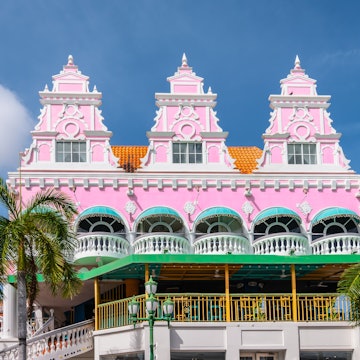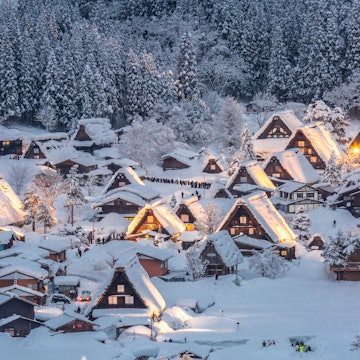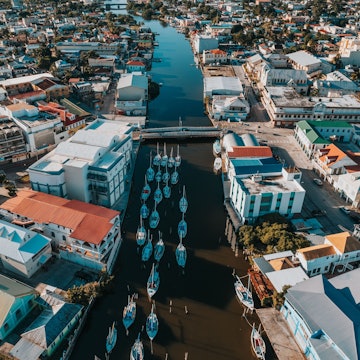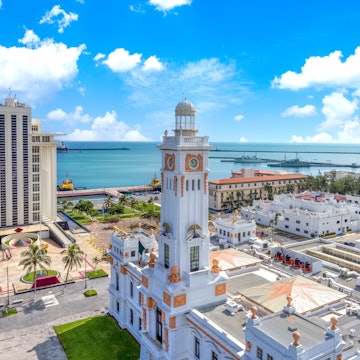
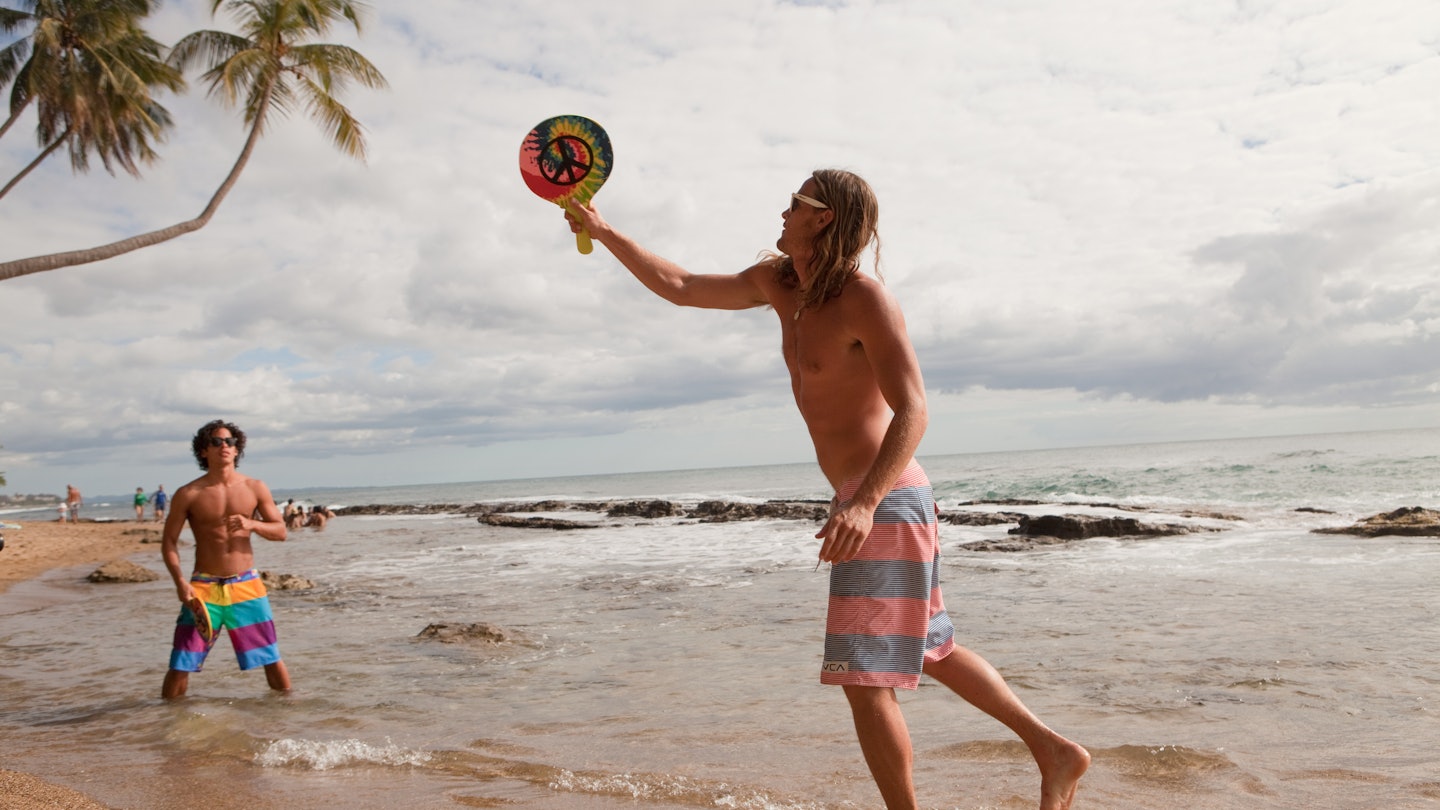
The beach is always free in Puerto Rico © Getty Images / Image Source
Blessed with white, sandy beaches, colorful architecture, world-class surfing, a rich musical history, and enviable arts, culture and culinary scene, Puerto Rico is a perfect escape for the intrepid and adventurous.
It's a place to catch a wave on a beautiful beach, wander centuries-old cities, and dive into the layered, multicultural history that makes this one of the most exciting corners of the Caribbean.
The island has become an expensive destination in recent years thanks to gentrification and its growing popularity with travelers from the lower 48. However, there are still quite a few top experiences that won’t cost a dime. Here are our favorite free things to do in Puerto Rico.
1. Find history in Old San Juan
The walled islet of San Juan turned 500 years old this year, and there’s no better way to celebrate than by walking through its tree-lined, cobblestone streets, marveling at the centuries-old homes that were once the center of life in the colonial era. In fact, in celebration of the 500th anniversary, the government of San Juan is offering free guided walking tours throughout the city if you reserve a spot in advance.
If you prefer to tour the city independently, start by visiting the monumental Catedrál de San Juan, the second oldest church in the Americas, founded in 1521. The cathedral was central to life in the city in Spanish times, and it remains one of the most enthralling places in San Juan, with its centuries-old mausoleums and paintings.
Afterward, walk to the beautiful Convento Los Dominicos, founded by the Dominican order back in 1523. It’s currently a hotel, but you can walk in for free and take a look at the creole tiles and interior courtyard garden.
La Fortaleza is currently the governor’s official residence, befitting a palace built in 1532. While it’s not possible to meet the governor, free 30-minute guided tours run from Monday to Friday between 8:15am and 3:30pm. Since La Fortaleza is a functioning official building, tours can be canceled at short notice; call before heading out.
Other noteworthy sights to visit for free include Casa Blanca, San Juan’s first fort and the former residence of conquistador Juan Ponce de León, and Plazuela de la Rogativa, where you can enjoy beautiful views of San Juan bay.
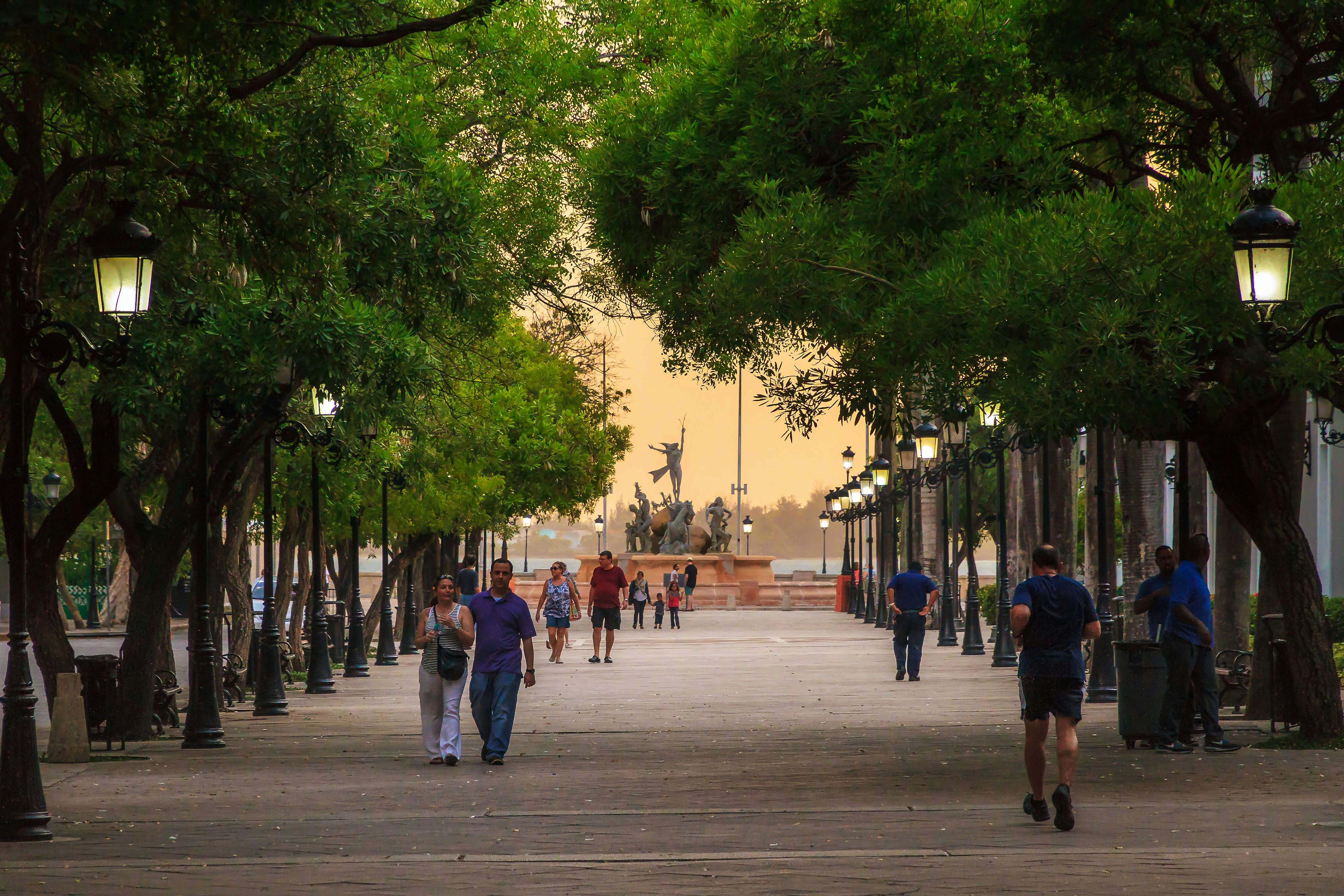
2. Stroll along Paseo de la Princesa
During Spanish colonial rule, the Puerta de San Juan functioned as the walled city's main commercial and military entrance. Today, it serves as one of the gateways to Paseo de la Princesa, a tree-lined, oceanside promenade where you’ll find families and lovers strolling and appreciating the breeze.
To the west, you can follow a 3-mile (4.8km) path that borders the Castillo San Felipe del Morro. While this is a newer addition to the military castle, you’ll be able to touch the old walls that once protected the city from pirates and rival powers.
Walking to the east will lead you to the heart of Paseo La Princesa, where you can find local artisans on the weekends, visit the old La Princesa Prison (now the home of the Puerto Rico Tourism Company), and sample some fine Puerto Rican rum-based drinks at Princesa Cocina Cultura.
3. Marvel at Santurce’s street art
The neighborhood of Santurce in San Juan holds a special place in the hearts of Puerto Ricans. The district has gone through many iterations since it was founded. It was a military bastion during Spanish colonial rule, an industrial shantytown in the 1930s and 1940s, a vibrant theatre and shopping district during the 1960s and 1970s, and then largely abandoned throughout the 1990s before its modern revival.
The neighborhood has come to represent the spirit of resilience, community and reinvention that distinguishes San Juan's largest barrio. It's most famous today as the home of the baseball team, Cangrejeros de Santurce, aka the Crabbers.
Walking through the steep streets of Santurce, you’ll find contrasting architectural styles, from Spanish colonial relics to classic Art Deco. Many buildings are covered with beautiful murals by renowned Puerto Rican and international street artists.
Start your walk at the intersection between Avenida Fernández Juncos and Calle Cerra, the epicenter of the annual street art festival Santurce es Ley. Here you’ll find works by local muralists such as Alexis Bousquet, Vero Rivera, Celso, La Pandilla, Pun18, Defy, Rey X and Javier Cintrón.
Keep an eye out for Bik Ismo’s hyper-realistic chrome rabbit, a local landmark. Don’t limit yourself to Calle Cerra and Calle Progreso; the street art continues towards Calle Loíza, where you can feel the sea breeze.
4. Dive into Puerto Rican culture at Ocean Park
One of the great things about Puerto Rico is that all beaches are public, so you can visit for free and stay as long as you’d like. One of the biggest beaches in the metropolitan area is Ocean Park – a long stretch of beachfront that begins in Condado and stretches through to the Dos Hermanos bridge in San Juan.
With its white sand and crystal blue water, it’s one of the most popular beaches for the residents of San Juan and a great spot to observe Puerto Rican beach culture.
Check it out at the weekend, when you can sample traditional ice cream from passing vendors, sip an ice-cold Medalla beer in the afternoon sun, and groove to the bombastic beats of reggaeton and salsa ringing out from nearby beach parties.
If you like to get wet, Ocean Park is extremely popular with surfers, bodyboarders and kiteboarders. Be sure to wear lots of sunblock and take an umbrella if you can, as there's limited shade and the sun can be punishing in the middle of the day.

5. Find living history in Ponce
Known as the “Pearl of the Caribbean,” Ponce, located in the southern part of the island, was founded in the 16th century and named in honor of conquistador Juan Ponce de León. The old center is dominated by Spanish neoclassical buildings and houses painted in the brightest shades of yellow, blue, green and orange.
The town’s most striking feature is the Plaza de las Delicias, an open-air plaza that contains bright, red sculptures of Ponce’s basketball team mascot – The Lion. It's a great spot to sit down and eat some traditional ice cream in the shade.
Equally emblematic are the plaza's red and black firehouse and its handsome cathedral – both played an important role in Ponce’s history. The historic town center is completely walkable and full of enthralling murals bound to inspire some photographic creativity.
6. Find creole culture in Caguas
The town of Caguas, located off Highway 52, is an obligatory stop for those looking to immerse themselves in the folk traditions of Puerto Rico, surrounded by winding country roads and brightly painted Spanish-era buildings.
The town center buzzes with Puerto Rican creole culture. During the day, head over to the Museo del Tabaco Hermínio Torres Grillo to learn about the history of the Puerto Rican tobacco industry and get your hands on some handmade cigars.
Housed in a bright, baby-blue, neoclassical Spanish colonial building that used to be Caguas’s City Hall, the Museo de Historia de Caguas is a historical gem. Inside, exhibitions will take you on a journey through local history, from the Taíno civilization to revolutionary uprisings by the criollo people of Caguas.
To learn about one of Puerto Rico’s most important literary voices, visit Casita Verde Abelardo Díaz Alfaro, where the writer spent the first years of his illustrious life. All of Caguas’ museums are free of charge and don’t require advanced booking.
Caguas becomes a different town at night, with vibrant clubs, quaint chinchorros (snack kiosks) and a killer art scene at El Paseo de las Artes. This new arts promenade features two monthly events: Festival Paseo de los Artistas, which showcases work from local artisans at an open-air market, and Al Fresco, where restaurants serve up their most famous dishes. Food and drinks tend to be budget-friendly, with local beers starting at USD$2.50.
9 best places to visit in Puerto Rico
7. Drive across the interior of Puerto Rico
To experience the full variety of Puerto Rico, you need to get out of San Juan. Though renting a car comes at a price, you’ll be rewarded with stunning views of the green rolling hills, high peaks and undeveloped tropical jungles that form the Cordillera Central.
Highway 52 offers great interior views as it crosses the mountain range from San Juan to the island's south coast. On a sunny day, you’ll see intense, changing shades of green and yellow, with a grand view of the turquoise majesty that is the Caribbean Sea once you reach higher altitudes around the hill town of Cayey.
The municipality of Cayey is known for one of Puerto Rico’s most sought-after culinary delights: lechón a la varita (roast pork). The search for perfect lechón is a local ritual, with the most famous plates being served up in the barrio of Guavate, where you'll also find budget-friendly traditional fare such as arroz con gandules (rice and pigeon peas), pasteles (a type of tamale) and guineos en escabeche (pickled green bananas).

8. Glide down the Las Pailas river
Deep inside El Yunque National Forest – Puerto Rico’s largest tropical rainforest – there are steep, snaking paths through lush, green vegetation that lead to an impressive system of rivers and creeks where you can bathe in pure water trickling down from the mountain tops.
Dotted with natural swimming holes, the river known as Las Pailas is a true hidden gem, known mostly to locals from the Luquillo municipality. Hidden behind local houses, the deepest swimming pool has a natural waterslide forged by centuries of running water. This slippery rock formation runs for approximately 30ft (9m), whooshing you down into a fish-filled natural pool. There are no official signs for this river, so ask a local for directions.
You’ll need shoes or hiking boots with good grips to hike down to the river. Note that the entrance to the swimming hole is on private property, so you’ll need to pay a small fee (approximately USD$5) to park your car on the owner’s property.
Puerto Rico's 7 best hiking trails
9. Find rugged nature at Faro Los Morillos
Also located in Cabo Rojo, Faro Los Morillos is a national wildlife refuge surrounding a historic lighthouse on the Los Morillos peninsula at the southernmost tip of the municipality. Follow rocky, unpaved roads to explore dry subtropical forests, hypersaline lagoons, salt marshes, marine lagoons, coral reefs and mangroves.
The nature reserve is like a painting come to life, with brine shrimp changing the color of the salt flats to deep hues of purple and pink. Put on your hiking boots and climb the steep, rocky hill to reach the lighthouse – it was constructed in 1882 and offers majestic views over the Caribbean Sea from its clifftop location. Stay away from the cliff's ledge; strong winds and loose rock have claimed the lives of tourists in the past.
Once you descend the hill, you’ll be greeted by one of Puerto Rico's most untouched, crystalline beaches, known to locals as Playa Sucia. With white sands and clear turquoise waters, this patch of open water is a great spot to swim in warm Caribbean waters or snorkel to spot fish, crabs and other marine wildlife.
Shade is hard to come by, so bring an umbrella and plenty of sunblock. Because this is a natural reserve, there are no kiosks or food available, so you'll also need a cooler with all the refreshments you’ll need for the day.

10. Swing at La Curva del Árbol Renace
There’s no better way to appreciate the Puerto Rican countryside than from one of the public swings placed at the top of some of the most striking mountains on the island. The most famous of these gravity-defying swings is in Salinas at La Curva del Árbol Renace, where you'll have a front-row, bird's-eye view of the Caribbean coastline and the peaks and valleys of Cayey. It's a favorite spot for Instagram snaps.
There are many more swings on the island, including the precariously balanced swing at Columpio de los Suspiros near the town of Naguabo on the south side of the El Yunque forest. You'll need to join a guided tour to find it, as it stands more than 1,000ft (305m) above sea level.
11. Party at El Poblado de Boquerón
If you’re looking for a party on any given weekend, El Poblado de Boquerón in Cabo Rojo is where you want to be. During the day, Balneario Boquerón fills with locals splashing in clear Caribbean waters. Things can get a little crowded, but if you arrive early enough, you’ll be able to carve out a little space for yourself.
There’s a small fee for parking (approximately $5), but it’s worth it, as you’ll be able to park closer to the water and transport refreshments to your chosen patch of beach with minimal hassle. Plan to spend the whole day lounging on the white and yellow sand.
Puerto Rico is on our 2022 Best of Travel list. For more stories from some of the world’s most exciting destinations click here.
Safety recommendations and restrictions during a pandemic can change rapidly. Lonely Planet recommends that travelers always check with local authorities for up-to-date guidance before traveling during Covid-19.
You may also like:
How to travel sustainably in Puerto Rico
Beaches, rum and nature: the 9 best places to visit in Puerto Rico
Why fall and winter are top times to visit Puerto Rico (and tips for the whole year)






